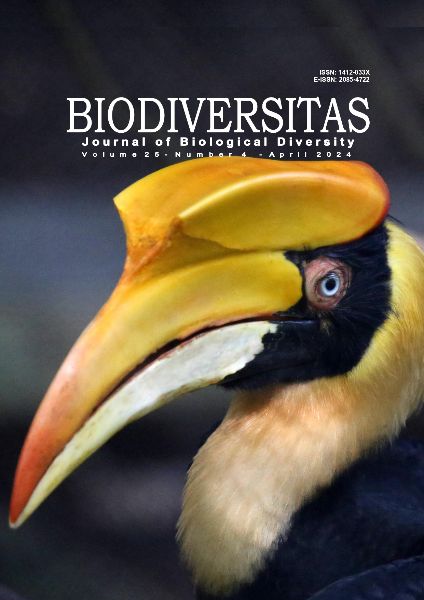Prevalence of gastrointestinal parasites in vipers (Serpentes: Viperidae) reared in Padang City, West Sumatra, Indonesia
##plugins.themes.bootstrap3.article.main##
Abstract
Abstract. Mairawita, Herwina H, Hidayat F, Janra MN, Diniyati F.. 2024. Prevalence of gastrointestinal parasites in vipers (Serpentes: Viperidae) reared in Padang City, West Sumatra, Indonesia. Biodiversitas 25: 1352-1358. Vipers are widely distributed worldwide, including in the Asian region, and are currently decreasing in their natural population due to various factors. The most prominent characteristic is the exploitation of vipers for being human pets. Among other cities in West Sumatra, Padang is considerably dense with reptile hobbyists and owners who keep reptiles for their fancy, including the vipers, as this snake taxon has a colorful morphological appearance. This study aims to investigate gastrointestinal parasites in reared vipers in Padang City in terms of parasitic species inventory and their prevalence. Parasites were collected from the feces of vipers in Padang City from November to December 2021. Parasite extraction was conducted at the Animal Taxonomy Laboratory, Department of Biology, Universitas Andalas, Padang, Indonesia. Fecal samples of reared viper species were obtained from 38 individuals (five genera and 10 species. Fecal samples were then processed with a centrifugation-float method to observe the parasites and four types of endoparasites were revealed, namely Kalicephalus spp. (38.8%), Ophidascaris spp. (33.3%), Oxyuris spp. (44.4%), and Rhabdias spp. (38.8%), in their egg stage. Gastrointestinal parasites in reared vipers in Padang City are more common as single infestation cases at 63% than mixed infestation cases at 32% and not infested only at 5%.
##plugins.themes.bootstrap3.article.details##
Most read articles by the same author(s)
- MAIRAWITA, AHMAD MURSYID, DAHELMI, FITHRIA DINIYATI, DELA LIDIA, NOVIKA PUTRI, MARSHA M. ARIFA, JEFRIAL, RYAN M. MAULANA, Co-occurrence of ectoparasites on wild rodents in Sipora Island, Mentawai, Indonesia with the zoonotic potential review , Biodiversitas Journal of Biological Diversity: Vol. 24 No. 11 (2023)
- MAIRAWITA, STUDY DUHA, HENNY HERWINA, The diversity of butterflies (Lepidoptera: Rhopalocera) at Tanahbala Island, North Sumatra, Indonesia , Biodiversitas Journal of Biological Diversity: Vol. 24 No. 3 (2023)

